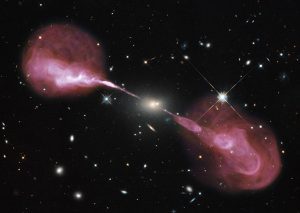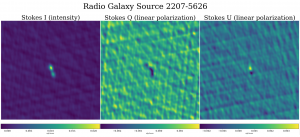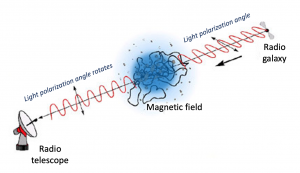Ariel is a fifth-year PhD student at the University of Toronto. She works under the supervision of Professor Bryan Gaensler, and her thesis focuses on extra–galactic magnetic fields – from active galactic nuclei (AGN) to the intergalactic medium.
Born and raised in Toronto (go Leafs go!), she received her Honours Bachelor of Science (specializing in Physics & Astronomy, and a minor in Mathematics) from the University of Toronto in 2017. During that time, she worked on projects analyzing the CMB as well as variable stars.
When not doing research, you can find Ariel outside (usually hiking, camping, or backpacking), reading books about history, or watching hockey!
My first exposure to even thinking about being an astronomer came from watching Star Trek: The Original Series (in all its cheesy glory) with my dad from a super young age (I think I got hooked at like age 5). After that, I would read books on astronomy and try to learn anything I could. Then, my dad and I would visit the David Dunlap Observatory (DDO) in Richmond Hill and listen to lectures from astronomers about a wide range of topics. These outreach events that I attended really had an impact on me and my academic path. In high school, I officially decided I wanted to study astronomy and applied for the Physics and Astronomy Specialist program at U of T for my undergrad! And, here I am 10 years later.
Can you tell us a little bit about your specific field of research?
What’s the most exciting thing about your research?
I think we’re at a really exciting time in radio astronomy; we’re about to witness a massive increase in the quantity and quality of the data that astronomers will be able to access. The precursor to the Square Kilometre Array (SKA), ASKAP, will essentially map the entire radio southern sky in full polarization, making it possible to understand extragalactic magnetism to a level we could not achieve with older, more limited data. I’m excited to explore the richness of data from the radio sky that is to come! I can just imagine all the incredible things we will be able to learn about magnetism in the next few years!
What do you hope will be your next step, professionally?
Right now, I know that I would really love to continue my research journey in astronomy with a post-doc position and, honestly, just have fun doing cool science for a few years. That’s something I’ll have to start applying for very soon. After a postdoc, my ambitions are very open-ended. I’m very interested in environmental conservation in Ontario and would love for my career path to somehow end up along those lines, but I don’t have a clear goal for right now. I’m just going to try to enjoy the journey over the next little while and not get too wrapped up in thinking about the more distant future.

An image of radio galaxy Hercules A. Radio galaxies host AGN (active galactic nuclei) and are primarily seen in the long-wavelength radio frequencies due to synchrotron emission. These galaxies usually contain an active central black hole that is actively “eating” surrounding matter. They also have well-formed radio jets and lobes that can be seen coming out of the central black hole. Credit: NASA.

These are three images of a distant radio galaxy 2207-5626, observed by the Australia Compact Telescope Array (ATCA) at radio frequencies used in Ariel’s research. This radio galaxy is much less resolved than Hercules A (image above), but you can still make out the radio jets and lobes in the image on the left. The central and right-most images show what the polarized light looks like from the radio galaxy – you can see dark and light patches where the lobes are located in the left-most image. Looking at the polarized light properties allows us to measure magnetic fields. Credit: Ariel Amaral.

This diagram depicts the process of “Faraday rotation,” a technique used to detect magnetic fields in distant astronomical objects. A distant radio galaxy emits polarized light; when this polarized light passes through a magnetic field, the polarization angle rotates. The amount of rotation the light’s polarization angle experiences is proportional to the magnetic field strength. Credit: Philipp P. Kronberg, Physics Today, December 2002. Edits by Ariel Amaral.
_________________________________________________________________________________________


